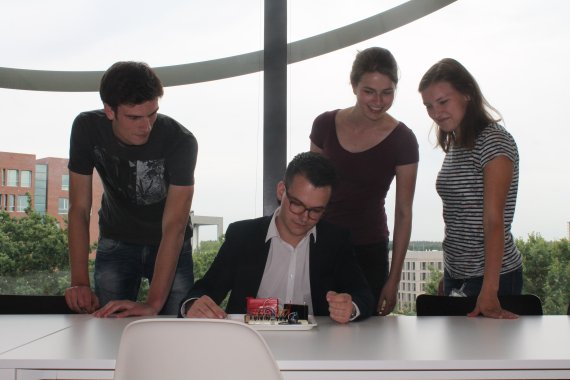© iGEM WUR
It might have seemed like the Zika fever suddenly surfaced last year, but that was not the case. ‘The virus already slumbered in Brazil for many years’, tells Niek Savelkoul, master’s student in Medical Biotechnology. ‘The thing is, it rarely got detected.’ Many other tropical diseases that are overlooked might prove just as dangerous as the Zika fever. Like the African sleeping sickness, for example, caused by a unicellular parasite (a protozoan) which eventually settles in the brain. ‘The timing of its discovery has a great influence on possibilities for treatment. We want to develop a fast tool that will allow reliable detection of diseases such as the Zika fever and the African sleeping sickness.’
Red flag bacterium
Niek is sitting at a large table in the mess of the Helix building. Three team members are sitting next to him. Since last November, the team counting a total of ten students has been the Wageningen delegation for the annual iGEM competition. During this international competition that is held in Boston each year, students try to solve a relevant societal problem using synthetic biology. The WUR team has a reputation to uphold: last year, Wageningen came in second in the master’s students’ category. They ‘modified’ an E. coli bacterium, allowing it to tackle the varroa mite – an important parasite that plagues the Western honey bee.
If we want to test for another disease, all that needs to be modified is that first gene.
The team want to use the E. coli bacterium once more, but this time as a red flag to detect diseases. ‘This is how it works’, explains Niek’s team member Bart Scholten. ‘We modify a gene in the bacterium, making it react to the presence of a specific disease. We make that reaction in the gene subsequently activate another gene. This in turn makes the bacterium fluoresce a bit, which can be observed using a LED lamp. If we want to test for another disease, all that needs to be modified is that first gene.’ To prove that this test can be easily modified, the students are preparing a test to detect the Zika fever (virus) and one for the African sleeping sickness (protozoan).
Unique test, but long from ready
If the idea of the Wageningen students can be realised, it will be unique. Never was there a test that immediately reacted to a pathogen and that could be used out in the field. ‘There are dipsticks on which you put a bit of blood, but these only react to the antibodies. This makes them less reliable, as they regularly give false positives’, tells Niek.
The students have a long road ahead before the field test will truly be available. Sabine van Oossanen is analysing computer models. She is also looking at the societal aspects of the projects together with Linda van Oosten. Stijn Prinsen spends a lot of time in the lab, while Jurre Steens is working hard to amass 30,000 euros for the research. In about three weeks, they will hear whether they will have the opportunity to show their plans in Boston. If their idea is still promising after that, they are considering starting a small business based on that concept.
The Wageningen iGEM team is still looking for financiers. You cansupportthem.
Additional reading (partly in Dutch):
Wageningen tweede met varroakiller
Blog: iGEM
Students create varroa killer

